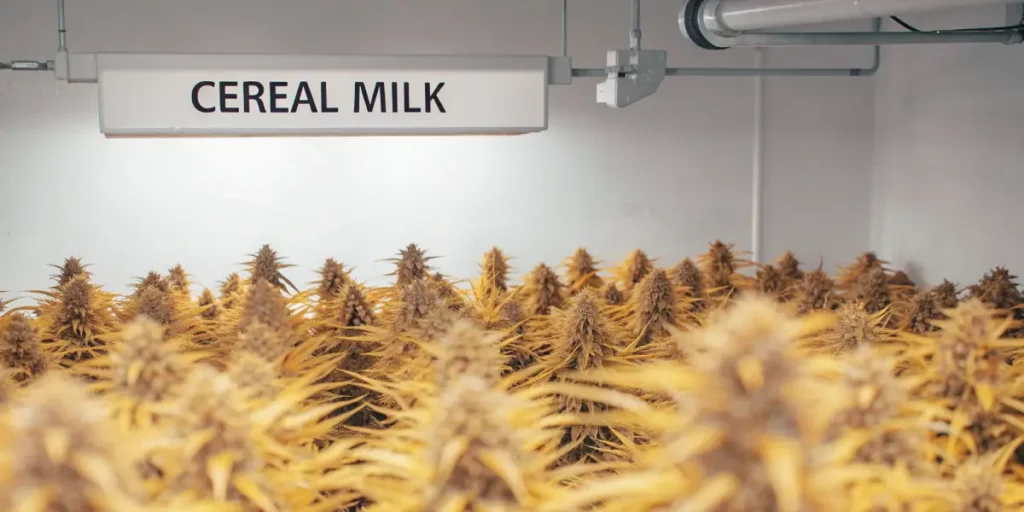Cereal Milk is a hybrid cannabis strain known for its sweet and creamy aroma, reminiscent of the sweet milk left in the bowl after a serving of fruity cereal. To grow this delightful strain, it is essential to have an understanding of its specific needs and characteristics. Cereal Milk thrives in environments where it can receive plenty of light and nutrients, making both indoor and outdoor growth viable under the right conditions. Understanding these initial requirements is crucial for a successful harvest.
First, it is important to consider the growing environment. For Cereal Milk, a controlled indoor setup is often recommended, as it allows you to manage temperature, humidity, and light exposure more precisely. Aim for temperatures between 70-80°F (21-27°C) during the day and slightly cooler at night. If growing outdoors, make sure the climate approximates these indoor conditions. Consistency in these environmental factors is essential to maximize yield and plant health.
Next, decide on the growing medium and type of cultivation. Cereal Milk can be grown effectively in soil or hydroponic systems. Soil growers should choose a nutrient-rich organic mix for optimal flavor, whereas hydroponic systems can provide rapid growth with more controlled nutrient delivery. When selecting your nutrients, focus on a balance of nitrogen, phosphorus, and potassium, along with essential micronutrients. Regularly monitor pH levels, aiming for a range between 6.0 and 6.5 for soil, and slightly lower for hydroponics.
The vegetative phase is crucial for Cereal Milk as strong vegetative growth sets the stage for a bountiful flowering phase. During this phase, maintain an 18-6 light schedule (18 hours of light, 6 hours of darkness). Regular pruning and topping can promote bushier growth, leading to more flowering sites. As the plant transitions to the flowering stage, switch to a 12-12 light schedule and adjust nutrient mixes to emphasize phosphorus and potassium.
During the flowering stage, the sweet and creamy aroma of Cereal Milk will start to become more pronounced. This stage typically lasts about 8-10 weeks. Be vigilant about maintaining ideal environmental conditions and avoiding stress factors like pests or nutrient burn, which can negatively impact the yield and quality of the buds. Close attention to trichome development will help you determine the best time to harvest, usually when trichomes turn from clear to a cloudy white with a hint of amber.
Finally, after harvesting, it’s essential to properly dry and cure the buds to enhance the rich flavors that Cereal Milk is known for. Hang the trimmed buds in a dark room with good air circulation, maintaining humidity around 50-60% and temperatures between 60-70°F (15-21°C). Once adequately dried, curing the buds in glass jars for at least two weeks will develop their full aroma, potency, and flavor profile, concluding your cultivation process with the highest quality harvest.
Cereal milk Strain Overview: Traits, Effects & Genetics
The cereal milk strain is a well-balanced hybrid, renowned for its delightful aroma and exceptional effects. This strain is a product of the creative breeding at Cookies Fam Genetics, emerging from a lineage that includes the popular strains Y Life (a combination of Cookies and Cherry Pie) and Snowman, a sativa-dominant Cookies phenotype. As a result, cereal milk combines the best traits from both parents, offering a unique profile that attracts cannabis enthusiasts worldwide.
One of the most notable traits of the cereal milk strain is its distinct aroma and flavor. When you first encounter cereal milk, you are met with a sweet, creamy essence reminiscent of the milk left after a bowl of sugary cereal, hence the name. This delightful blend of sweet, creamy, and fruity notes creates an enticing sensory experience that lingers long after consumption. It pairs this extraordinary aroma with a visually appealing appearance, characterized by dense, frosty buds covered with trichomes, offering subtle hues of purple intertwined with vibrant orange pistils.
The effects of cereal milk are as enjoyable as its flavor profile, delivering a balance that caters to both recreational and medicinal users. Users often report an initial euphoric uplift, coupled with increased creativity and energy, making it suitable for daytime use. As the cerebral high subsides, a relaxing body effect takes over, which can help alleviate physical tension without causing sedation. This balanced mix of effects makes cereal milk ideal for users seeking both mental and physical wellness, providing relief from stress, anxiety, and mild pain while maintaining clarity and focus.
Genetically, cereal milk boasts a balanced hybrid structure, typically containing around 50% indica and 50% sativa traits, although some variations might lean slightly towards one side. Its THC levels generally range between 18% and 23%, providing a potent kick that seasoned users appreciate. This relatively balanced genetic foundation allows cereal milk to offer versatile growth characteristics suitable for a variety of cultivation conditions. It can thrive indoors or outdoors, given proper care and attention to environmental factors like humidity and light exposure. Overall, cereal milk’s robust genetic background contributes significantly to its popularity, making it a staple choice for both growers and consumers.
Optimal Environment to Grow Cereal Milk Successfully
Cereal Milk, a balanced hybrid cannabis strain known for its rich, sweet flavors and potent effects, thrives in a controlled environment where specific conditions are met to ensure healthy growth and optimal yields. This strain requires a dedicated approach, focusing on providing the right temperature, humidity, and light. Understanding and managing these factors is crucial for any grower aiming to maximize the potential of Cereal Milk.
The ideal temperature range for growing Cereal Milk is between 70°F and 80°F (21°C to 27°C) during the day, with a slight drop at night to mimic natural conditions. Maintaining stable temperatures is crucial, as fluctuating temperatures can stress the plants and affect their growth. Temperature control can be achieved using air conditioning systems, heaters, and fans. Additionally, ensure that the temperature does not drop below 60°F (16°C) during the dark cycle to prevent stunted growth or mold issues.
Humidity is another essential aspect of creating the optimal environment. Cereal Milk plants prefer a relative humidity (RH) level of 40%-50% during the vegetative stage, reducing it to 30%-40% in the flowering phase. Controlling humidity levels with dehumidifiers or humidifiers, depending on your regional climate, helps prevent mold and mildew, especially during the flowering stage when the plants are more prone to such issues due to dense buds.
Lighting is a critical component in cannabis cultivation, and Cereal Milk requires intense, consistent light to thrive. During the vegetative stage, provide around 18 to 24 hours of light daily using full-spectrum LED lights, which are energy-efficient and emit low heat, minimizing the risk of heat stress. When transitioning to the flowering stage, reduce the light to 12 hours per day to trigger the plant’s flowering response. Position lights appropriately to avoid light burn while ensuring they are close enough for efficient photosynthesis.
Finally, ensuring your growing space is adequately ventilated is vital for maintaining optimal environmental conditions. Proper air circulation distributes CO2 effectively, strengthens plant stems, and reduces the chances of pests or fungal infections. Implement an exhaust system complemented by oscillating fans to create airflow, which supports Cereal Milk’s robust growth. Maintaining these environmental conditions meticulously will ensure that your Cereal Milk plants grow vigorously and produce high-quality yields.
Grow Room Setup for Cereal Milk Plants
Cereal Milk, a balanced hybrid cannabis strain known for its sweet and creamy flavor profile, requires a carefully engineered grow room setup to achieve optimal growth and potency. The environment you create must cater to its specific needs, considering factors such as light, temperature, humidity, air circulation, and space. As a medium to tall plant, Cereal Milk benefits from ample vertical space to accommodate its natural growth patterns. Preparing your grow room with these elements in mind will set the foundation for healthy, flourishing plants.
Lighting is a crucial factor in the successful cultivation of Cereal Milk. High-intensity discharge (HID) lights, or modern LED full-spectrum systems, provide the necessary bright, consistent light that mimics the sun’s natural patterns required for robust growth. Position your lights at an appropriate height to prevent leaf burn while ensuring adequate light penetration to the lower parts of the plants. Adjust the photoperiod accordingly, with a typical vegetative cycle extending for about 18-24 hours of light, transitioning to 12 hours during flowering to stimulate bud production.
Temperature and humidity play significant roles in the indoor cultivation of Cereal Milk. Maintain temperatures between 70-80°F (21-27°C) during the day and slightly cooler at night. Humidity levels should be kept around 50% during the vegetative stage, decreasing to about 40% during flowering to prevent mold and mildew. Utilize digital hygrometers and thermostats to monitor these parameters closely and regulate them using air conditioning, heaters, or humidifiers as needed.
Adequate air circulation is vital in preventing stagnant air and ensuring the plants receive a steady supply of carbon dioxide. Install oscillating fans within the grow room to keep the air moving, reduce the likelihood of pest infestations, and help strengthen the plant stalks. Additionally, employing a proper ventilation system with intake and exhaust fans will help regulate the internal environment and maintain fresh air flow.
Design the layout of your grow room to provide Cereal Milk plants with sufficient space to expand horizontally and vertically. This strain has a tendency for moderate stretching during the flowering phase, so allow for extra room to avoid overcrowding. Implementing techniques such as topping, pruning, and training (like the Screen of Green method) can help manage plant height and encourage an even canopy, leading to balanced light exposure and increased yield potential.
Indoor Growing Tips for Cereal Milk
Cereal Milk, a balanced hybrid cannabis strain known for its deliciously sweet flavor and potent effects, thrives indoors under controlled conditions. One key aspect of indoor cultivation is managing the light schedule. Cereal Milk benefits from a consistent light cycle, typically 18 hours of light followed by 6 hours of darkness during its vegetative stage. This helps the plants develop robustly, laying a strong foundation for flowering. LED grow lights are a preferred choice for many growers due to their energy efficiency and ability to produce a full spectrum of light, closely mimicking natural sunlight.
Climate control is another critical component when growing Cereal Milk indoors. This strain prefers temperatures between 68°F to 80°F during the day, with a slight drop at night. Maintaining relative humidity levels at 40% to 60% during the vegetative phase and reducing it slightly during flowering can help prevent mold and pests. Ventilation is essential in maintaining these conditions and ensuring that plants receive a steady supply of fresh air, which is crucial for photosynthesis and overall plant health.
Feeding Cereal Milk the right nutrients plays a vital role in maximizing yield and potency. During the vegetative phase, a nitrogen-rich fertilizer is recommended, whereas, in the flowering stage, a fertilizer higher in phosphorus and potassium will support bud development. Monitor the plants closely for nutrient burn or deficiencies, and adjust feeding accordingly. pH management is equally important; ensuring that water and nutrient solutions stay within a pH range of 6.0 to 6.5 can help the plants absorb nutrients efficiently.
Finally, proper training techniques can enhance the growth and yield of Cereal Milk. Techniques such as topping, low-stress training (LST), or the screen of green (ScrOG) can encourage a bushier plant structure, promoting more bud sites and efficient light penetration to lower branches. Regular pruning of lower leaves also improves air circulation and directs the plant’s energy towards developing larger buds. By employing these indoor growing tips, cultivators can optimize their Cereal Milk harvest, achieving a bountiful yield with resin-rich, aromatic buds.
Outdoor Growing Tips for Cereal Milk
Cereal Milk is a cannabis strain that has gained popularity for its unique flavor profile and potent effects. Growing Cereal Milk outdoors can be rewarding, but success requires understanding the plant’s specific needs. Start by selecting a location with ample sunlight, as Cereal Milk thrives with at least six hours of direct sunlight daily. Ensure the site is protected from harsh winds that can damage the plants or hinder growth. Furthermore, the area should have proper drainage to prevent waterlogging, which can harm root health and lead to rot.
Soil quality is another critical factor in the outdoor cultivation of Cereal Milk. This strain performs best in well-aerated, nutrient-rich soil. Consider enriching the planting site with organic compost or a balanced organic fertilizer before planting to boost essential nutrients. Maintaining slightly acidic to neutral pH levels (around 6.0 to 7.0) in the soil is crucial for optimal nutrient absorption. Regularly check pH levels throughout the growing season, as excessive fluctuations can affect plant health and yields.
Water management is essential, especially in outdoor environments. Cereal Milk requires consistent moisture; however, overwatering can lead to root problems. It’s advisable to adopt a “deep and infrequent” watering schedule, allowing the soil to dry out slightly between sessions. Mulching around the base of the plants can help retain moisture and regulate soil temperature. Monitoring the weather and adjusting the watering schedule accordingly will ensure the plants are healthy and reduce the risk of stress.
Outdoor growers should also consider pest management strategies for Cereal Milk. The strain is susceptible to common pests such as aphids, spider mites, and caterpillars. Implementing organic pest control methods like neem oil or introducing beneficial insects such as ladybugs can mitigate pest issues without affecting the plant’s quality. Regular inspections and prompt action at the first sign of infestation can significantly reduce potential damage.
Finally, keep an eye on temperature fluctuations. While Cereal Milk is relatively robust, extreme temperatures, especially during flowering, can impact the yield and quality of the buds. Providing shade during intense heat waves and using frost protection measures during cooler nights can safeguard your crop. By understanding and implementing these considerations, growers can enjoy a bountiful and high-quality Cereal Milk harvest.

How to Germinate & Propagate Cereal Milk
Germinating and propagating Cereal Milk, a hybrid cannabis strain known for its balanced effects and sweet flavors, is a task that requires attention to detail and patience. To begin this process, it is essential to gather quality seeds from reputable sources, as the genetic quality of the seed will significantly influence the plant’s growth and final yield. Once acquired, ensure that the seeds are stored in a cool, dry place until you are ready to initiate germination.
To successfully germinate Cereal Milk seeds, consider using the paper towel method, which is simple yet effective. Start by moistening two clean paper towels with distilled water and placing a few seeds between them. Then, place the paper towels on a plate and cover them with another plate to create a dark, moist environment. Store the setup in a warm location, ideally between 70-85°F (21-29°C), as this temperature range encourages optimal germination. Within 3-10 days, the seeds should start to sprout, revealing tiny seedlings.
After germination, the seedlings are ready for propagation. Carefully transfer each sprouted seed into a small pot filled with high-quality potting soil, ensuring the root is facing downwards. It’s crucial to handle the delicate seedlings with care to avoid damaging them. Maintain a warm, humid environment and provide plenty of indirect sunlight or a suitable grow light to encourage healthy growth. As the plants develop, ensure they receive adequate water without waterlogging the soil, which can impede root development.
Throughout the propagation phase, monitoring the health and growth of the Cereal Milk plants is vital. Regularly check for signs of nutrient deficiency or pest issues, as these can greatly impact plant health. Using a balanced, cannabis-specific nutrient regimen and employing preventative pest measures can help ensure robust growth. By carefully managing these early stages, growers can set the foundation for a thriving Cereal Milk cultivation process.
Vegetative Stage: Nurturing Your Cereal Milk Plants
The vegetative stage is a critical phase in the life cycle of your Cereal Milk plants, as this is when they develop the structures needed for future bud production. During this stage, focus on promoting strong root growth, sturdy stems, and lush foliage. Cereal Milk plants typically benefit from a robust nutrient schedule rich in nitrogen to support their rapid growth. Ensure they receive adequate light exposure, with 18 to 24 hours of light per day to maximize photosynthesis and build energy reserves. Investing in quality grow lights can make a significant difference in the vigor of your plants.
A crucial aspect of nurturing your Cereal Milk plants during the vegetative stage is providing them with the correct environment. Maintaining the right temperature and humidity levels is essential for optimal growth. Temperatures should ideally range between 70°F to 85°F (21°C to 29°C), with humidity levels around 50% to 70% to prevent issues such as mold or mildew. Adequate airflow is also vital; make sure your grow room has a good ventilation system to stabilize environmental conditions and to provide a steady supply of CO2, which is necessary for photosynthesis.
Besides to environmental factors, regular maintenance of your Cereal Milk plants is equally important. Pruning is a beneficial technique to encourage bushier growth and to remove any yellowing leaves that may sap energy from the plant. Training techniques, such as low-stress training (LST), can be employed to evenly distribute light across the canopy and to manage plant height. Regularly check for pests and diseases, as early detection and management can save your crop from substantial damage. A vigilant eye and consistent care during the vegetative stage will lay the foundation for a successful flowering phase.
Flowering Cereal Milk: What to Expect
Cereal Milk, a popular hybrid cannabis strain known for its balanced effects and striking flavor profile, typically enters its flowering stage around 8 to 10 weeks after the vegetative phase. During this crucial period, growers can expect the plants to exhibit rapid development as they prepare for bud production. The flowering stage is an exciting time for cultivators, as the distinctive characteristics and potential yield become increasingly apparent.
One of the first noticeable changes during the flowering stage of Cereal Milk is the emergence of dense, resinous buds that start to take shape. These buds are often covered in a thick layer of trichomes, which contribute to the strain’s potency and unique aroma. A sweet and creamy scent reminiscent of cereal milk will gradually intensify, giving growers a tantalizing preview of the flavor profile that makes this strain so popular among cannabis enthusiasts.
As flowering progresses, Cereal Milk plants will require careful attention to their growing environment to achieve optimal results. Factors such as lighting, temperature, humidity, and nutrient levels must be meticulously managed. Adequate light exposure is essential for maximizing bud development, while maintaining a consistent temperature range between 65-80°F (18-27°C) and keeping humidity levels in check will help prevent mold and pest issues.
Another aspect growers should anticipate is the strain’s potential for considerable vertical and lateral growth during the flowering phase. Implementing techniques like plant training and pruning can help manage its size and ensure light penetrates effectively to the lower buds, promoting even growth throughout the plant. This not only enhances yield but also improves the overall quality of the harvested buds.
Overall, growers should be prepared for an engaging and rewarding process when flowering Cereal Milk. With a keen eye on environmental conditions and timely interventions, this strain can develop into a high-yielding plant with buds that captivate both the senses and the mind. This guide will further define the satisfaction of cultivating such a renowned strain, known for its robust flavors and balanced effects.
Feeding Cereal Milk: Fertilizers & Nutrient Schedule
Cereal Milk is a distinctive cannabis strain celebrated for its rich and creamy flavor palette reminiscent of the milk left after a bowl of cereal. To achieve its full potential in terms of both flavor and potency, a well-structured feeding regimen is essential. The plant requires a careful balance of nutrients to thrive, and understanding this balance will ensure robust growth and a promising yield. Start by choosing high-quality soil, as this forms the foundation for healthy growth. The soil should be well-aerated and rich in essential nutrients to support the initial stages of the plant’s life.
During the vegetative phase, Cereal Milk, like many cannabis strains, requires a higher nitrogen content to support vigorous growth and healthy leaf development. Balanced grow formulas with a macro-nutrient ratio of around 3-1-2 (Nitrogen-Phosphorus-Potassium) are generally recommended. In addition to nitrogen, maintaining adequate levels of calcium and magnesium ensures the sturdy development of stems and leaves. These micro-nutrients can often be supplemented through products known as Cal-Mag, which are readily available in gardening stores.
As the plant transitions into the flowering stage, the nutrient needs of Cereal Milk undergo significant changes. The focus shifts from nitrogen to phosphorus and potassium, which are crucial for the development of flowers and buds. A bloom formula with a NPK ratio of about 1-3-2 ensures the support Cereal Milk requires in this crucial period. This doesn’t exclude the importance of micronutrients like sulfur and zinc during flowering, which aid in terpene production, enhancing the plant’s characteristic aroma.
Regular monitoring of pH levels and electrical conductivity (EC) during both vegetative and flowering stages is crucial. For Cereal Milk, the ideal pH range in soil is between 6.0 to 6.8, which allows nutrients to be absorbed effectively. Regularly flushing the growing medium every few weeks also helps prevent nutrient lockout, ensuring that the plant can absorb all the necessary nutrients without any hindrance. By adhering to these guidelines and maintaining an attentive eye on the health of your plants, you can reap the full benefits of the Cereal Milk strain.
Pest and Disease Prevention for Healthy Cannabis Plants
Successfully growing cannabis, especially a unique strain like Cereal Milk, requires diligent attention to pest and disease prevention. The first step in ensuring healthy growth is to maintain a clean growing environment. Sanitation is paramount; regularly clean your tools, pots, and the growing area to prevent the buildup of harmful pathogens. Avoid overwatering, as it can create a humid environment conducive to mold and mildew growth. Proper spacing between plants ensures good air circulation, reducing the chance of fungal diseases.
One of the most effective strategies to protect your Cereal Milk cannabis plants from pests is to implement an integrated pest management (IPM) approach. Start by regularly inspecting your plants for signs of common cannabis pests such as spider mites, aphids, and whiteflies. Introduce beneficial insects like ladybugs and predatory mites into your garden; these natural predators can significantly reduce pest populations without the use of chemical pesticides. Additionally, employing organic pest control sprays made from neem oil or insecticidal soap can help manage minor infestations safely.
Using resistant genetics and providing optimal plant nutrition also play crucial roles in disease prevention. Selecting robust and disease-resistant strains can save time and resources in battling potential infections. Similarly, maintaining a balanced nutrient schedule tailored to your plants’ specific growth stages can enhance their immune responses, making them less susceptible to diseases. Be especially vigilant for nutrient imbalances that can weaken plants, making them more vulnerable to stress and subsequent pathogen attacks.
Incorporating these methods into your daily cultivation practices will cultivate a resilient environment for your cannabis plants. By staying proactive and employing a multifaceted prevention strategy, you can ensure that your Cereal Milk seedlings develop into lush, productive plants. A healthy crop is not only a source of pride but also contributes to a more successful and sustainable cannabis cultivation journey.

Harvesting & Drying Cereal Milk the Right Way
Cereal Milk, a popular hybrid cannabis strain known for its dense, resinous buds and creamy flavor, requires careful attention during the harvesting and drying process to maintain its quality and potency. Harvesting Cereal Milk at the right time is crucial for maximizing its cannabinoid and terpene profile. A majority of growers recommend looking for buds with milky white trichomes, indicating peak THC levels. If the trichomes turn amber, the THC begins to degrade into CBN, reducing the psychoactive effects. Observing the pistils’ color change from white to a deep rust is also a marker of maturity.
Once you’ve determined that your Cereal Milk plants are ready for harvest, it is essential to handle them delicately to avoid damaging the delicate trichomes that coat the buds. Use sterilized scissors to trim the branches carefully. Leaving longer stems during harvest can be beneficial, as it allows for easier handling and more convenient hanging during the drying process. Remember to work in a clean and well-ventilated area to prevent mold and contaminants from affecting the harvested cannabis.
Drying is a critical post-harvest step that can significantly influence the flavor, aroma, and potency of your Cereal Milk. Hang the trimmed branches upside down in a dark, humid-controlled environment. The ideal drying room should maintain a temperature of around 60-70°F with a humidity level of 50-60%. These conditions help to slow down the drying process, preserving the terpenes and cannabinoids that contribute to Cereal Milk’s signature effects and flavors. Typically, the drying process lasts about 7-10 days but regularly check the texture and condition of the buds to ensure optimum results.
After drying, it’s time to cure the buds to further enhance their quality. Place the dried buds into airtight glass jars, filling them about 75% full to ensure adequate airflow. Store these jars in a cool, dark place, and open them daily for the first two weeks to release excess moisture and introduce fresh air. This process, known as burping, helps stabilize the moisture content and enhances the final aroma and potency. After curing for 2-3 weeks, your Cereal Milk should be optimally prepared for consumption, showcasing its creamy flavors and potent effects to their fullest potential.
Cereal milk Strain Type: Indica, Sativa or Hybrid?
Cereal Milk is a balanced hybrid strain that has gained significant popularity among cannabis enthusiasts for its unique flavor profile and versatile effects. The strain’s genetic lineage is often attributed to the crossing of the acclaimed strains, Girl Scout Cookies (GSC) and Snowman, which both contribute to its remarkable characteristics. As a hybrid, Cereal Milk offers the best of both worlds, providing users with a harmonious blend of Indica and Sativa effects. This balance makes it suitable for a variety of situations and preferences, appealing to both recreational and medicinal users.
The Indica traits of Cereal Milk typically manifest in its relaxing body effects. Many users report a sense of calm and physical tranquility, making it an excellent choice for unwinding after a long day or alleviating stress and tension. However, unlike some heavy Indica strains, Cereal Milk does not usually lead to excessive sedation, allowing users to remain functional while enjoying its calming properties. This makes it ideal for evening use when you want to relax without being completely immobilized.
On the other hand, the Sativa attributes of Cereal Milk contribute to its uplifting and mood-enhancing effects. Consumers often experience a burst of creativity and mental clarity, which can be inspiring for artistic endeavors or social interactions. The cerebral stimulation is balanced enough that it does not become overwhelming, allowing users to focus and engage in thoughtful conversations or activities. This balance between mental alertness and physical relaxation is a hallmark of the hybrid experience, making Cereal Milk a versatile choice.
Overall, the hybrid nature of Cereal Milk means it can be used at various times throughout the day, depending on the user’s needs and tolerance levels. Its dual characteristics make it appealing to those seeking both therapeutic benefits and recreational enjoyment. Whether you’re looking to spark creativity, manage stress, or simply experience a unique flavor, Cereal Milk’s hybrid profile has something to offer for everyone. As with any strain, it’s important to consider personal preferences and desired effects when choosing Cereal Milk as your strain of choice.
Why Grow Cereal Milk? Key Benefits for Cultivators
Cereal Milk, renowned for its unique flavor profile and impressive genetic lineage, has become a favorite among cannabis cultivators seeking both quality and market appeal. This hybrid strain is a cross between the ever-popular Cookies and Cherry Pie strains, inheriting a rich and complex terpene profile. Its name suggests a creamy, sweet aroma reminiscent of milk-soaked cereal, attracting a wide array of enthusiasts. The distinct bouquet of flavors not only enhances consumer demand but also provides cultivators with a competitive edge in an increasingly crowded market, making Cereal Milk a highly sought-after strain.
Aside from its alluring scent and taste, Cereal Milk offers substantial yields, making it a rewarding choice for both commercial and home growers. This strain thrives in controlled environments, with its sturdy structure and resilience to common pests and diseases aiding in a successful cultivation process. With proper care and attention, cultivators can expect bountiful harvests, characterized by dense, trichome-rich buds that showcase its premium quality. Its robust nature makes it an appealing option for cultivators from all experience levels, from beginners to seasoned growers.
Moreover, the growing popularity of Cereal Milk is not solely attributed to its aroma and yield. This strain is also celebrated for its balanced and potent effects, offering consumers a satisfying mix of relaxation and euphoria without overwhelming sedation. These appealing characteristics increase customer retention and loyalty, ensuring that this strain remains a staple in dispensaries and private collections alike. As consumer demand continues to rise for strains offering unique experiences, cultivators can capitalize on Cereal Milk’s reputation for quality and return on investment, solidifying its status as a worthwhile addition to any cultivation project.
Potential Challenges When Growing Cereal Milk
Cereal Milk, a balanced hybrid strain known for its delightful flavor profile reminiscent of sweet milk and sugary cereal, presents certain challenges to cultivators. One of the initial challenges is maintaining the ideal climate conditions. Cereal Milk thrives in environments where temperature and humidity levels are closely monitored. Sudden fluctuations in these parameters can lead to stress, negatively impacting the plant’s growth and yield. Ensuring that your grow space maintains a consistent temperature between 70-80°F with humidity levels ranging from 40-50% during the flowering stage is crucial for optimal growth.
Another challenge encountered when growing Cereal Milk is nutrient management. This strain is moderately nutrient-sensitive, meaning that both nutrient deficiencies and excesses can adversely affect its development. Achieving the right balance of macronutrients like nitrogen, phosphorus, and potassium, along with essential micronutrients, is vital. Overfeeding can lead to nutrient burn, manifesting in discolored or scorched leaf tips, while underfeeding can stunt growth and reduce bud quality. Regularly monitoring your plants and using a balanced, strain-specific nutrient schedule can mitigate these issues and promote healthy, robust plants.
Pest and disease control is a further challenge when cultivating Cereal Milk. Like many cannabis strains, it is susceptible to common pests such as spider mites and aphids, as well as fungal infections like powdery mildew. Implementing preventative measures is key; this includes maintaining cleanliness in the grow space, using pest-deterrent plants, and regularly inspecting plants for signs of infestation. Organic pest control methods and fungicides can be effective when used appropriately. By being proactive, growers can safeguard their crop and ensure a successful harvest.
Furthermore, Cereal Milk’s bushy structure requires regular pruning and training to manage its height and encourage better light penetration. This process involves shaping the plant to optimize light exposure to all bud sites, ensuring an even canopy. Techniques such as topping or using the Screen of Green (SCROG) method can help growers maximize yields. However, if not done carefully, these techniques can stress the plants, so growers should be cautious and knowledgeable about plant training practices.
Is Cereal Milk Worth Buying? Here’s What You Need to Know
Cereal Milk is quickly becoming a favorite among cannabis connoisseurs. This strain is known for its unique flavor profile that combines the creaminess of milk with a sweet, sugary cereal taste. It’s not just the flavor that’s appealing; the hybrid strain offers a balanced high that can be uplifting and relaxing. But before deciding whether Cereal Milk is worth buying, it’s essential to understand its characteristics, effects, and potential benefits.
One of the main reasons cannabis enthusiasts gravitate towards Cereal Milk is its potency. With THC levels typically ranging from 18% to 23%, it is suitable for both recreational and medicinal users looking for a powerful yet manageable high. The effects are generally uplifting and euphoric, making it a great option for social settings or creative pursuits. It might provide a cerebral high that stimulates conversation and laughter, while its Indica side induces a degree of relaxation, calming both body and mind.
Another factor to consider is its aroma and flavor, which are often likened to a bowl of sugary cereal with milk, evoking a sense of nostalgia for many users. The terpenes that contribute to this distinctive profile, such as limonene and caryophyllene, not only add to the sensory experience but may also offer therapeutic benefits. Limonene can enhance mood and relieve stress, while caryophyllene is known for its anti-inflammatory properties, which could be valuable for those using cannabis for medicinal reasons.
When evaluating whether Cereal Milk is worth buying, availability and price are practical considerations. As a strain that has surged in popularity, it can sometimes be challenging to find, particularly in areas where cannabis products are in high demand. Moreover, due to its desirability and unique profile, Cereal Milk might be priced slightly above average compared to other strains. However, many users believe the distinctive experience it offers justifies any additional cost.

FAQs about Cereal Milk
What makes the Cereal Milk strain unique compared to other cannabis varieties?
The Cereal Milk strain stands out for its sweet, creamy flavor reminiscent of milk and sugary cereal, paired with balanced hybrid effects. It offers an uplifting yet relaxing experience that appeals to both recreational and medicinal users, making it one of the most sought-after hybrid strains in the market.
What are the best conditions to grow the Cereal Milk strain successfully?
Cereal Milk thrives in warm, controlled environments with daytime temperatures between 70–80°F (21–27°C) and moderate humidity. Whether grown indoors or outdoors, maintaining consistent light exposure, airflow, and nutrient balance ensures strong, resin-rich buds and optimal yields.
How long does it take for the Cereal Milk strain to flower?
The flowering stage of the Cereal Milk strain typically lasts 8 to 10 weeks. During this period, maintaining proper light cycles (12 hours of light and 12 hours of darkness) and monitoring trichome development helps achieve the perfect balance of potency and flavor before harvest.
Can I grow the Cereal Milk strain outdoors, and what should I watch out for?
Yes, the Cereal Milk strain can be grown outdoors in climates that provide plenty of sunlight and stable temperatures. Growers should watch for pests and excessive humidity, as dense buds are prone to mold. Good soil drainage and regular pest control are essential for a healthy outdoor harvest.
How can I enhance the flavor and aroma of my Cereal Milk harvest?
To bring out the Cereal Milk strain’s signature creamy-sweet aroma, focus on proper drying and curing. Hang buds in a dark, well-ventilated space at 60–70°F with 50–60% humidity, then cure them in glass jars for at least two weeks to develop full terpene richness and smoothness.





